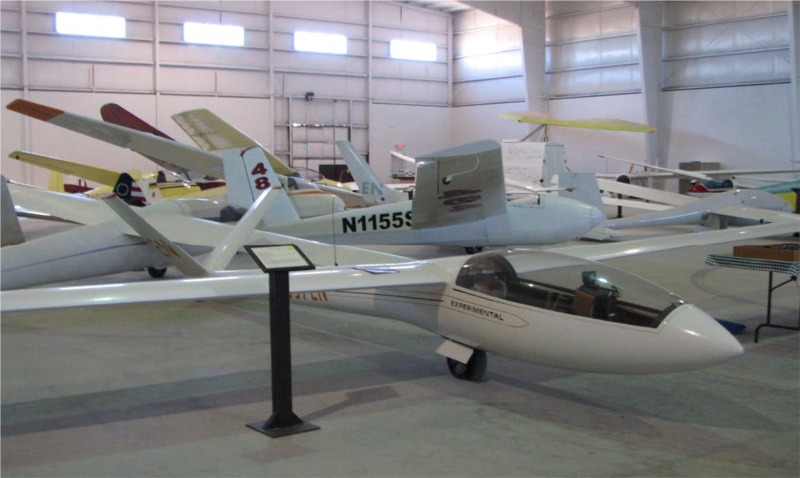
HP-18 N897EN
taken from
Southwest Soaring
Quarterly Newsletter of the U.S. Southwest
Soaring Museum
November 2012

|
|
Glider History
This beautiful sailplane was built by Konrad Nierich of Arizona and donated
to the museum in 2005. The HP-18 kit (serial number 5) and trailer kit were
purchased from Dick Schreder in 1975. Construction time was 2000 hrs in 2 years
including the trailer. First flight occurred August 1977. Konrad’s professional
background included10 years as a journeyman toolmaker in Germany, and 28 years
as a mechanical engineer with the US defense industry. Prior to tackling the
HP-18, he built two boats and flew RC model sailplanes of his own designs and
construction for 13 years. As a result, this glider exhibits outstanding workmanship.
A photo of this glider (prior to addition of winglets) appears in Jane’s World
Sailplanes and Motorgliders [Andrew Coates, Flying Books, Ziff-Davis Publishing
Company, 1978].
Richard Schreder, Designer
Richard E. Schreder (9/25/1915-8/2/2002) was a successful designer and outstanding
contest pilot, who designed, built and flew the HP-8 to win the US National
Championships in 1958 and 1960. He was also responsible for the innovative HP-10,
the HP-11, which placed third in the 1962 World Championships, and the well-known
HP-14, and the 15 m HP-18 and HP-18A. The HP-18 was one of the most-successful
homebuilts in terms of the number built. Many badge legs were flown in this
aircraft. See photo later in this issue from the March 1976 cover of Soaring
Magazine, and read the article in that issue, “Building the HP-18, Part 1, by
Dick Schreder.
Dick Johnson said, "I personally believe that Dick’s gentlemanly flying, brilliant ideas, and low cost kit production for the U.S. gliding movement were, for twenty some years, the single most significant contribution to the American sport of soaring.”
Construction
The HP-18 was sold in kit form for home or club assembly. It is an all-metal
aircraft with machined aluminium spars and precut hard foam ribs spaced at 10
cm intervals that are bonded to the aluminum skin. The fuselage was supplied
as a pre-formed Kevlar pod, aluminium body, and V-tail. A two-piece flush canopy
covers the cockpit. The cantilever shoulder-set wings feature camber-changing
flaps and ailerons running the length of the trailing edge. A retractable landing
wheel with brake and a steerable tailwheel comprise the landing gear. The control
stick is side mounted with attached brake handle and trim tab.
Nierich Modifications
The tail wheel is Konrad’s own design (He jokes, “Expensive German gliders wished
they had!”)
1) it fully retracts,
2) has suspension,
3) has a wide tire,
4) is steerable (with rudder).
5) has spring loaded overload cam to remove steering feature and be full swivel
(in a ground loop or rough landing),
6) a small pull wire in the tailcone pulled out and locked will make the tailwheel
full swivel. Pull-wire unlocked and tailweel aligned with v tail will make system
full steering.
The original 2-part canopy was replaced with one clear and one tinted one piece front hinged canopy (good optics) and one lever interchange. A cockpit controlled pin will hold canopy open 6" min to full open. Canopy is in flight ejectable.
A camera mount was added to the left winglet.
Flying the HP-18
Konrad suggests that the winglets should be used all the time for much better
roll control, thermaling, L/D, and being in the groove!. Filling of water ballast
is simple. Close the dump valve (located inside the left side behind the pilot).
The wing tip is lifted, the plug is removed from the wing tip, and water is
filled from a water hose or equivalent. Water will overflow when spar is full.
Partial filling is not recommended. The HP-18 climbs well with a full load.
The center of gravity with water is hardly changed.
| Flap Settings (Approximate): | ||
| Degrees | MPH | Knots |
| -10 | 80 & up | 70 & up |
| -5 | 70 & up | 61 & up |
| 0 | 50 & up | 43 & up |
| +5 | 50 & up | 43 & up |
| +10 | 55 - 75 Medium lift | 48 - 65 Medium lift |
| +15 | 60 - 75 Strong lift |
52 - 65 Strong lift |
| +30 to +80 | 60 Min 80 Max Landing Only! |
52 Min 70 Max Landing Only! |